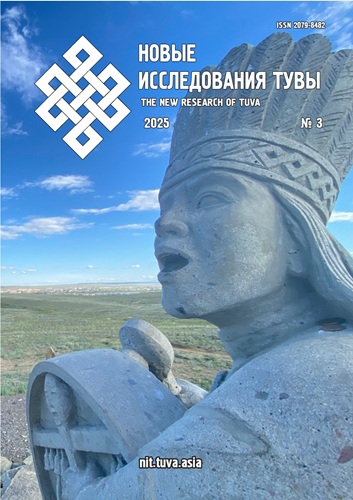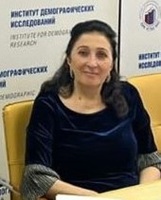A Comparative Analysis of the Organization of Turkic States: Population Size and Birth Rate as Indicators of Demographic Sustainability
DOI:
https://doi.org/10.25178/nit.2025.3.24Keywords:
Organization of Turkic States; Azerbaijan; Kazakhstan; Kyrgyzstan; Turkey; Uzbekistan; demographic sustainability; birth rate; demographic transitionAbstract
This study considers the main indicators of demographic sustainability in the Republic of Azerbaijan, the Republic of Kazakhstan, the Kyrgyz Republic, Turkey, and the Republic of Uzbekistan, which are members of the Organization of Turkic States (OTS), an entity whose important area of activity is addressing and preventing demographic challenges. The countries are united by steady population growth; however, the dynamics vary significantly between them, which affects their demographic sustainability. The analysis focuses on population size and birth rates. The methodological framework of the research is based on demographic development concepts and the theory of demographic transition. The study covers the period from 2009 to 2023.
Indicators of birth rates among the populations of these Turkic countries are typologized. It has been revealed that Turkey and Azerbaijan demonstrate population reproduction trends similar to those observed in European Union countries (low birth rates and postponement of first births to older age groups). It is found that Turkey’s socio-economic development indicators contribute to greater demographic sustainability compared to the other OTS countries. In several OTS countries, there are observed tendencies for emigration, which may adversely affect demographic sustainability.
References
Abylkalikov, S. I. (2021) Features of demographic development of Tuva: the contribution of migration in the demographic balance. New Research of Tuva, no. 4, pp. 131–142. (In Russ.) DOI: https://doi.org/10.25178/nit.2021.4.10
Valiahmetov, R. M., Lomanova, A. K. and Abylkalikov, S. I. (2024) Comparative analysis of demographic dynamics in the context of human potential development in Bashkortostan and Tatarstan (1959–2021). New Research of Tuva, no. 4, pp. 360–376. (In Russ.) DOI: https://doi.org/10.25178/nit.2024.4.23
Vishnevsky, A. G. (2014) Demographic revolution changes reproductive strategy of the species Homo Sapiens. Demograficheskoe obozrenie, vol. 1, no. 1, pp. 6–33. (In Russ.)
Gyul, Ya. E. and Ozen, Y. (2020) Formation of culture among Turkic peoples. Universum: Psychology and Education, no. 2 (68), pp. 4–9. (In Russ.)
Demographic wellbeing of Russia. National demographic report (2022) / Ryazantsev, S. V., Rostovskaya, T. K. et al.; ed. by S. V. Ryazantsev. Moscow, Perspektiva. 108 p. (In Russ.) DOI: https://doi.org/10.19181/monogr.978-5-88045-557-7.2022
Demographic development of post-Soviet countries (1991–2021): trends, demographic policy, prospects. Analytical report (2021) / Arkhangelsky, V. N. et al.; ed. by S. V. Ryazantsev. Moscow, Perspektiva. 200 p. (In Russ.) DOI: https://doi.org/10.19181/monogr.978-5-89697-379-9.2021
Ildarkhanova, Ch. I. (2018) Family-demographic trends in the multicultural space of Turkic peoples of the Altaic language family. Uchenye zapiski Krymskogo federal'nogo universiteta im. V. I. Vernadskogo. Sotsiologiya. Pedagogika. Psikhologiya, vol. 4 (70), no. S2, pp. 11–25. (In Russ.)
Maksakova, L. (2016) Demographic and migration potential of Uzbekistan. Narodonaselenie, no. 1–1 (71–1), pp. 83–89. (In Russ.)
Reer, D. (2014) Economic and social consequences of demographic transition. Demograficheskoe obozrenie, vol. 1, no. 4, pp. 41–67. (In Russ.)
Rybakovsky, L. L. and Kozhevnikova, N. I. (2020) Demographic development strategy of Russia: determinants and centuries-long vector. Uroven' zhizni naseleniya regionov Rossii, vol. 16, no. 4, pp. 9–20. (In Russ.) DOI: https://doi.org/10.19181/lsprr.2020.16.4.1
Ryazantsev, S. V. and Sydygalieva, B. A. (2024) New migration trends from Kyrgyzstan to the Russian Federation. DEMIS. Demograficheskie issledovaniya, vol. 4, no. 3, pp. 105–118. (In Russ.) DOI: https://doi.org/10.19181/demis.2024.4.3.7
Ryazantsev, S. V. and Rybakovsky, L. L. (2021) Demographic development of Russia in the 20th–21st centuries: historical and geopolitical dimensions. Vestnik Rossiyskoy akademii nauk, vol. 91, no. 9, pp. 810–819. (In Russ.) DOI: https://doi.org/10.31857/S0869587321090085
Ryazantsev, S. V. and Miryazov, T. R. (2021) Demographic wellbeing: theoretical approaches to definition and evaluation methodology. DEMIS. Demograficheskie issledovaniya, vol. 1, no. 4, pp. 5–19. (In Russ.) DOI: https://doi.org/10.19181/demis.2021.1.4.1
Sayakbayeva, A. A. and Kenzhekaraeva, A. Zh. (2016) Problems of poverty and demographic development in the Kyrgyz Republic and its regions. Vestnik universiteta Turan, no. 1 (69), pp. 105–112. (In Russ.)
Fauzer, V. V., Lytkina, T. S. and Smirnov, A. V. (2018) Sustainable development of northern regions: demographic dimension. Ekonomika regiona, vol. 14, no. 4, pp. 1370–1382. (In Russ.)
Fauzer, V. V., Smirnov, A. V. and Fauzer, G. N. (2021) Demographic assessment of sustainable development of small and medium-sized cities of the Russian North. Ekonomika regiona, vol. 17, no. 2, pp. 552–569. (In Russ.) DOI: https://doi.org/10.17059/ekon.reg.2021-2-14
Başkaya, Z. and ve Özkılıç, F. (2017) Changes in fertility in Turkey (1980–2013). Journal of International Social Research, vol. 10, no. 54, pp. 404–423. DOI: https://doi.org/10.17719/jisr.20175434605
Becker, C. and Paltsev, S. V. (2004) Economic Consequences of Demographic Change in the Former USSR: Social Transfers in the Kyrgyz Republic. World Development, vol. 32, no. 11, pp. 1849–1870. DOI: https://doi.org/10.1016/j.worlddev.2004.06.009
Capdevila, P., Stott, I., Beger, M. and Salguero-Gómez, R. (2020) Towards a Comparative Framework of Demographic Resilience. Trends in Ecology & Evolution, vol. 35, no. 9, pp. 776–786. DOI: https://doi.org/10.1016/j.tree.2020.05.001
Colantoni, A., Halbac-Cotoara-Zamfir, R., Halbac-Cotoara-Zamfir, C., Cudlin, P., Salvati, L. and Gimenez Morera, A. (2020) Demographic Resilience in Local Systems: An Empirical Approach with Census Data. Systems, vol. 8, no. 34. DOI: https://doi.org/10.3390/systems8030034
Coşan, B. (2022) Fertility change in Türkiye: risks and opportunities in terms of social policy. Sosyal Politika Çalışmaları Dergisi, vol. 22, no. 56, pp. 597–617. DOI: https://doi.org/10.21560/spcd.vi.963155
Dadabaev, T. (2016) Evaluations of perestroika in post-Soviet Central Asia: Public views in contemporary Uzbekistan, Kazakhstan and Kyrgyzstan. Communist and Post-Communist Studies, vol. 49, no. 2, pp. 179–192. DOI: https://doi.org/10.1016/j.postcomstud.2016.03.001
Doker, A. C., Turkmen, A. and Emsen, O. S. (2016) What are the Demographic Determinants of Savings? An Analysis on Transition Economies (1993–2013). Procedia Economics and Finance, vol. 39, pp. 275–283. DOI: https://doi.org/10.1016/S2212-5671(16)30324-0
Erdoğan Coşar, E. and Yavuz, A. A. (2021) Okun’s law under the demographic dynamics of the Turkish labor market. Central Bank Review, vol. 21, no. 2, pp. 59–69. DOI: https://doi.org/10.1016/j.cbrev.2021.03.002
Kossymova, G., Kulbarak, S., Zhalalova, A., Kaliyeva, N. and Zadakhanova, A. (2024) The Concept of “World” in Ancient Turkic World View. Journal of Nationalism, Memory & Language Politics, vol. 18, no. 2. Sciendo, pp. 70–86. DOI: https://doi.org/10.2478/jnmlp-2024-0005
Landry, A. (1909) Les trois théories principales de la population. Scientia, vol. 3 (6), article 121 [online] Available at: https://philpapers.org/rec/LANLTT (access date: 16.10.2024).
Landry, A. (2020) La révolution démographique. Ined Éditions. 280 p. DOI: https://doi.org/10.4000/books.ined.15465
Mukhtarov, F., Fox, S., Mukhamedova, N. and Wegerich, K. (2015) Interactive institutional design and contextual relevance: Water user groups in Turkey, Azerbaijan and Uzbekistan. Environmental Science & Policy, vol. 53, part B, pp. 206–214. DOI: https://doi.org/10.1016/j.envsci.2014.10.006
Peker, M. (2016) Demographic Transition in Turkey. Sosyoloji Dergisi, vol. 34, pp. 133–196 [online] Available at: https://dergipark.org.tr/tr/download/article-file/593982 (access date: 16.10.2024).
Polat, Z. A. (2019) Legal, economic, geographical and demographic analysis of the acquisition of Real Estate by foreign nationals in Turkey. Land Use Policy, vol. 85, pp. 207–217. DOI: https://doi.org/10.1016/j.landusepol.2019.04.003
Rakhmetova, R. and Abenova, K. (2013) Economic Mechanisms of the Demographic Policy of Kazakhstan. Procedia Economics and Finance, vol. 5, pp. 631–636. DOI: https://doi.org/10.1016/S2212-5671(13)00074-9
Rostovskaya, T. K. and Sitkovsky, A. M. (2024) Demographic development resources: On the unification of concepts in demographic research. Economic and Social Changes: Facts, Trends, Forecast, vol. 17, no. 1, pp. 178–200. DOI: https://doi.org/10.15838/esc.2024.1.91.10
Semiz, Y. (2010) 1923–1950 Turkey’s Population Growth Policy During The 1923-1950 Period and the Issue of Compulsory Marriage Law (Bachelor Tax). Selçuk Üniversitesi Türkiyat Araştırmaları Dergisi, vol. 27, pp. 423–469 [online] Available at: https://dergipark.org.tr/tr/pub/sutad/issue/26306/277276 (access date: 16.10.2024).
Skirbekk, V., Stonawski, M. and Alfani, G. (2015) Consequences of a universal European demographic transition on regional and global population distributions. Technological Forecasting and Social Change, vol. 98, pp. 271–289. DOI: https://doi.org/10.1016/j.techfore.2015.05.003
Spankulova, L. S. and Chulanova, Z. K. (2024) Data on the demographic forecast of the Kazakhstan population. Data in Brief, vol. 52. DOI: https://doi.org/10.1016/j.dib.2023.109985
Tolesh, F. and Biloshchytska, S. (2024) Forecasting international migration in Kazakhstan using ARIMA models. Procedia Computer Science, vol. 231, pp. 176–183. DOI: https://doi.org/10.1016/j.procs.2023.12.190
Uskelenova, A. T. and Nikiforova, N. (2024) Regional development of Kazakhstan: Theoretical premises and reality. Regional Science Policy & Practice, vol. 16, issue 3. DOI: https://doi.org/10.1111/rsp3.12616
Valeh, G. T. (2016) Turkic world’s cultural policy in the context of culture, art and education. International Journal of Philosophy and Social-Psychological Sciences, vol. 2, no. 1, pp. 7–11 [online] Available at: https://sciarena.com/storage/models/article/traAsBhZUnBqA58H2nXewqM3igBADCuVFYmJMZp8KHjYVwcUh3uWGciXiMqS/turkic-worlds-cultural-policy-in-the-context-of-culture-art-and-education.pdf (access date: 16.10.2024).
Yunusbayev, B., Metspalu, M., Metspalu, E., Valeev, A., Litvinov, S., Valiev, R. et al. (2015) The Genetic Legacy of the Expansion of Turkic-Speaking Nomads across Eurasia. PLoS Genet, no. 11(4), article e1005068. DOI: https://doi.org/10.1371/journal.pgen.1005068
Published
How to Cite
For citation:
Rostovskaya T. K., Sagynbayeva A. and Suleymanli E. A Comparative Analysis of the Organization of Turkic States: Population Size and Birth Rate as Indicators of Demographic Sustainability. New Research of Tuva, 2025, no. 3, pp. 407-420 (In Russ.). DOI: https://doi.org/10.25178/nit.2025.3.24
Issue
Section

This work is licensed under a Creative Commons Attribution-NonCommercial 4.0 International License.

Author(s) license holder(s) grant rights for their work to the journal (grantee of a license) under the simple non-exclusive open license in accordance with Art. 1286.1 «Open license for a research work, work of literature or fine arts», Civil Code of the Russian Federation.
New Research of Tuva publishes articles under the Creative Commons Attribution-NonCommercial license (CC BY-NC).
Since it is an open license, author(s) reserve the right to upload the article to their institutional repository, submit it to another journal (if it allows republications), or republish it on their own website (in full, or in part).
However, several conditions apply here:
a) The republished version must always contain the name(s) and affiliation(s) of the author(s), the original title and the hyperlink to the original version on the New Research of Tuva website;
b) It must be in open access, free of charge, and no category of readers must be in any way whatsoever advantaged over general readership.
c) should the contribution be submitted elsewhere by its author(s) without substantial modification (30% or more of original text unchanged), the body of the article should contain a disclaimer that the original version was published in New Research of Tuva (with a link to the respective page)
The CC-BY-NC is a non-revocable license which applies worldwide and lasts for the duration of the work’s copyright.











